
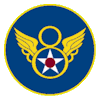

January 24, 2010
Volume II, Issue 2
www.303rdBG.com
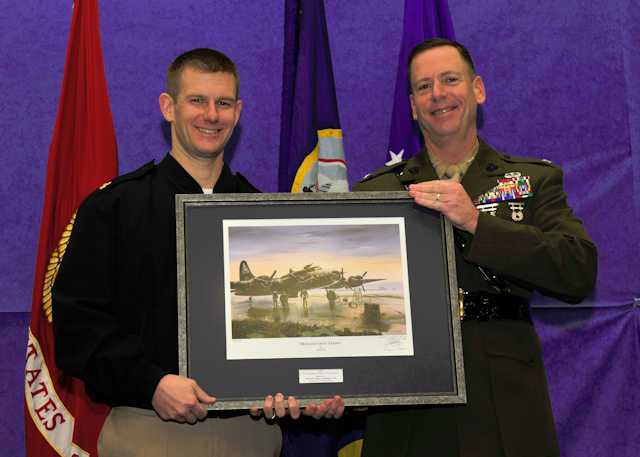 |
Awarded to JAC Sailor
by Peter G. Park, Commander's Action Group
JIOCEUR Analytic Center
"I will strive to live up to the ideals of support to the mission exemplified by MSgt. Fabian S. Folmer," said Navy Chief Petty Officer Charles J. Mosbarger during an interview with Air Force TSgt Alana Ingram of Armed Forces Network following the January 8th ceremony in which he was honored.
The MSgt. Fabian S. Folmer Award for Excellence in Support Services honors the now 91-year old Folmer who served as crew chief on the famed B-17F "Hell's Angels," the first Flying Fortress to complete 25 missions in the 8th Air Force during World War II. See the full story on MSgt Folmer and his amazing achievements here. The award was presented in the same WWII hangar in which Folmer would have worked repairing battle damage during the war.
Chief Mosbarger serves as the Noncommissioned Officer in Charge of the JIOCEUR Analytic Center Personnel Division. The award cites Mosbarger for his leadership of a team of Army, Navy, and Air Force personnel providing outstanding customer services to over 600 military members.
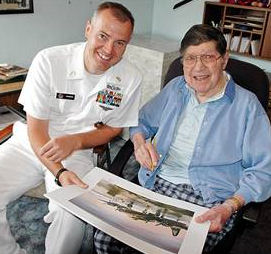 |
The Armed Forces Network story on the award will air in either late January or early February, and will be sent to television stations near both Mosbarger and Folmer's homes in the U.S.
Two other awards, both named in honor of 303rd Bomb Group S-2 Intelligence Officers, were also presented at the ceremony. Air Force Master Sgt. Teresea Stiner received the 1Lt Peter M. Curry Award. The Curry Award recognizes the enlisted professional who made the most significant contribution to the accomplishment of the JAC mission. Ms. Anne Buelow was the winner of the LtCol Carlton M. Smith Award, awarded to officers or civilians for Analytical Excellence.
![]()
Introduction by 2Lt Frances Nunn Greenan
photos by LtCol James T. Rogers, MD
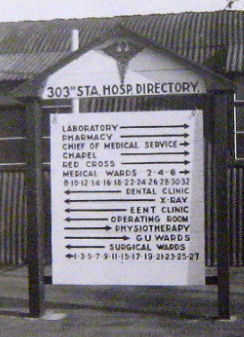 "In the spring of 1943, Major Thomas Thompson, an orthopedic surgeon at Walter Reed Army Medical Center, began recruiting personnel for an overseas medical unit. In July, 1943, the 303rd Station Hospital was formed at Camp McCall, North Carolina. Major Thompson was the original Commanding Officer of the unit.
"In the spring of 1943, Major Thomas Thompson, an orthopedic surgeon at Walter Reed Army Medical Center, began recruiting personnel for an overseas medical unit. In July, 1943, the 303rd Station Hospital was formed at Camp McCall, North Carolina. Major Thompson was the original Commanding Officer of the unit.
"1Lt Florine Thompson was assigned as Chief Nurse. 2Lt Gladys Gillilaud, Head Nurse of the Enlisted Men's Orthopedic Ward and 2Lt Frances Nunn, Head Nurse of the Officer's Orthopedic Ward at Walter Reed received orders on 10 July 1943 to report to the 303rd Station Hospital at Camp McCall. Additional female personnel assigned were a dietitian, physical therapist, and three Red Cross Workers.
"On the 23rd of August 1943, the 303rd Station Hospital including thirty-nine male officers, five female officers, three Red Cross workers and 392 enlisted men were ordered "To proceed from Camp McCall to Camp Kilmer, New Jersey, to arrive no later than 1600, 31st August 1943. This is a permanent change of station, movement by motor and/or rail." At Camp Kilmer they were joined by seventy-two 2Lt Army Nurses."
From Camp Kilmer, these 500+ medical personnel traveled to the 303rd Station Hospital location, near Molesworth. The 303rd Station Hospital served the medical needs of thousands of servicemen until it was closed in the spring of 1945.
The names of these medical personnel, and others who followed, are mostly unknown to us and are not included in the 303rd personnel roster. While they were not stationed at Molesworth, they were a supporting organization that played a big part in the success of the 303rd Bomb Group, as well as the other allied forces in the area. They are honored as a Support Organization on the 303rd Bomb Group Memorial, near the main gate of RAF Molesworth. The 303rd Bomb Group was fortunate to have such a top-notch medical facility virtually next door. You can see an aerial view of the hospital grounds in the excellent photograph located here.
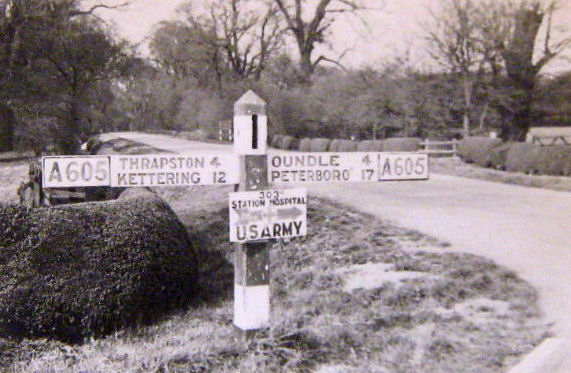
We recently received some rare photos of the 303rd Station Hospital taken by LtCol (then Major) James T. Rogers, MD. LtCol Rogers, was a physician and surgeon, assigned to the 303rd Station Hospital as the Executive Officer from January 1, 1944 to May 18, 1945. The photos shown here are courtesy of the Rogers family. LtCol Rogers' son Timothy also provided the transcription of the newspaper article below, from Page 6 of the Northamptonshire Evening Telegraph, February 23, 1944. More of LtCol Rogers' photos can be viewed here.
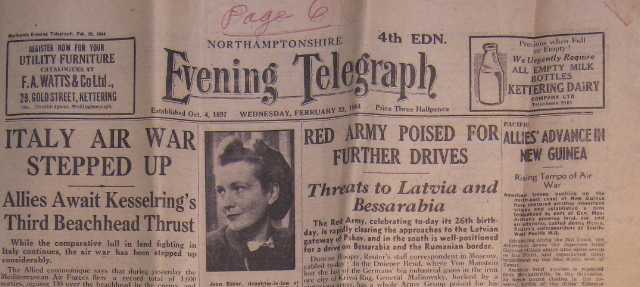
Established October 4, 1897 Wednesday, February 23, 1944 Price Three Halfpence
'Evening Telegraph' Visit to Transformed Estate
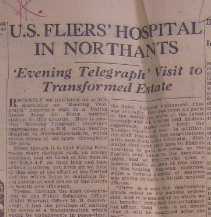 Recently we published an article describing an “Evening Telegraph” reporter’s visit to a United States Army Air Force bomber station in this country. Here is another “Evening Telegraph” reporter’s impression of a U.S. Army Station Hospital in Northamptonshire, which serves troops of all types throughout the area.
Recently we published an article describing an “Evening Telegraph” reporter’s visit to a United States Army Air Force bomber station in this country. Here is another “Evening Telegraph” reporter’s impression of a U.S. Army Station Hospital in Northamptonshire, which serves troops of all types throughout the area.
Often though it is that Flying Fortress make daylight raids on enemy territory, and we think of the men of the U.S.A.A.F. on their long and hazardous journeys yet little do we hear of that side of the effort of the United Nations which helps to maintain flying personnel and other of the Forces in health and efficiency.
To-day, through the kind co-operation of the Public Relations Officer (Chief Warrant Officer M. D. Goldenberg), I had the privilege of visiting the scene of a transformation which would be unbelievable in peace-time; the parkland attached to an ancient mansion now being occupied by innumerable huts which constituted a first-rate hospital, living accommodation for medical officers and men.
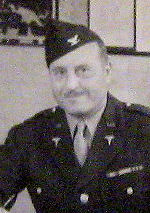 |
“The countryside is very beautiful–we do not have the fine hedges that you have here,” he remarked when asked his opinion of England. “You do not have the socialibility that we have,” he went on, “but that is explained by the English tradition of every man’s home being his castle.”
“At first we thought the English were sort of aloof,” he observed “but when we understood their love and pride in their homes, it changed our whole attitude; and we got a better appreciation of the people.”
Himself the embodiment of geniality, and that “bedside manner” which is essential to create confidence with patients, the Colonel (who also served in the last war) then gave a comprehensive picture of the layout of the hospital buildings, as indicated on plans. In an atmosphere of cool and calculated efficiency, it was an interesting revelation to hear him remark that, in emergency cases, they did not let the making of records of in-coming patients interfere with attention to their immediate needs.
It was obvious that good use was being made of the extensive grounds, now intersected with well-made pathways, which would shortly be covered overhead for the benefit of the patients.
The library being mentioned, it was learned that in addition of having the finest hospital equipment that was available, they had from all parts of the world the fruits of the latest research and of surgical and medical experience, particularly from the Russian theatre of war. In addition, the staff frequently had consultation with men from other hospitals. Also, whilst they sent their men to English hospitals to gain new ideas, so the English sent theirs to the American units, and at the present time a famous plastic surgeon of this country was touring American hospitals while a famous surgeon of America was giving lectures to British medical officers.
“There is a very fine relationship which exists in the medical profession and it is something by which we all benefit,” remarked the commanding officer, “and there is no doubt that it will be continued after the war.”
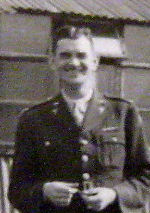 |
In addition to extractions and such-like dentistry, there are mechanics and the equipment and material for the making of false teeth. Those concerned in this work feel they are doing a particularly valuable service as it helps to get the air personnel quickly back on to operations. Airmen cannot go on missions when their artificial teeth are broken because they cannot control the oxygen tube. If the dentists had to send away for a replacement, the airmen would be three weeks away from sorties, but through going to this hospital the artificial teeth they require are completed in about two days so that they are back in the air without delay. Also in the case of a jaw fracture, the dental staff can make a splint in one day.
“Everything is as in civilian life at its best, and perhaps better,” said the officer in charge, and he mentioned that among recent “customers” was a commanding officer of a bomber wing who traveled 100 miles to be treated.
Patients have included R.A.F. officers, Fighting French and Polish men, whilst emergency cases sometimes include civilian employees at the hospital. Painless extractions were truly painless, it was asserted, and it was mentioned that an improved type of local anesthetic was in use, containing an organic substance that replaced adrenalin, which sometimes was the cause of a type of nausea in the past.
Adjacent was the X-ray dental room, where the last word in X-ray cameras was engaged in photographing a section of the jaw of a member of the U.S.A.A.F.
“He has trouble with a tooth at high altitudes,” explained the X-ray operator, “and I think it is a large filling in the tooth which is probably causing the trouble; so we are taking the photograph to confirm, or otherwise, our suspicions.”
Our reporter next visited the eye, ear, nose and throat clinic. Here, at his request, he went through some of the tests ordinarily given fighter pilots. Lieut. Jennings, in charge of this work, demonstrated, in addition, several of the instruments he uses in diagnosing systemic disease from the appearance of the inner coats of the eye.
Captain Schoolman, chief of the ear, nose and throat department was in the act of treating patients with sinus disease by modern methods.
Most comprehensive was the survey given by Major Needham B. Bateman, chief of the surgical service. He went to great pains to show the various departments, commencing with the operating theatre, where was standing an English-made sterilizer that was kindly loaned until their own American machine arrived.
Those patients able to enjoy recreation were found to be having a happy time at a film show, or enjoying themselves at the Red Cross Club of which the secretary is Miss Lybie Pintner. Several were working with leather making wallets suitable for carrying pound notes, since the American dollar is smaller in size, and the men found the wallets they had were inadequate. Many things, as explained by Miss Miriam Follmer, who is in charge of recreation work, are also made of plaster, glass from damaged bombers, and salvaged tin cans.
To add to the patients’ pleasure there was a radio-gram, snooker and table tennis tables, and a library, a special place being reserved for newspapers from hometowns. Tournaments and social parties were held every week, as revealed by the program on the notice board of the week’s activities. Beside the work attached to this side of the organization, the Red Cross volunteers also help by writing letters home for those men with fractures or hand injuries, and running all kinds of errands for them.
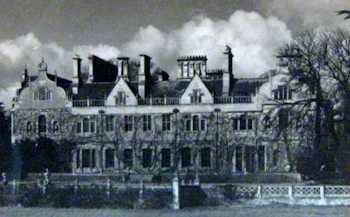 |
Thus fittingly concluded the tour of the large-scale array of buildings and the efficient hospital service behind the “front line,” the value of which, to the fighting forces, is inestimable.
![]()
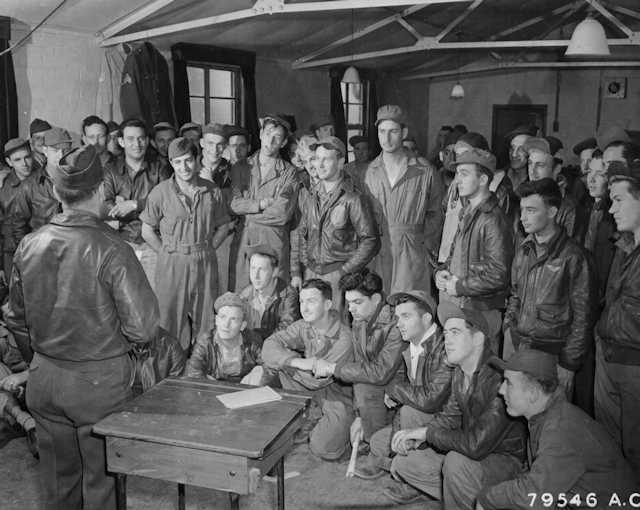
May 1944: B-17 Gunners of the 360th Bomb Squadron, 303rd Bomb Group are briefed by Lt. Kenneth W. Davey, Gunnery Officer from Webster Grove, Missouri, before take-off on a mission from their base at Molesworth, England.
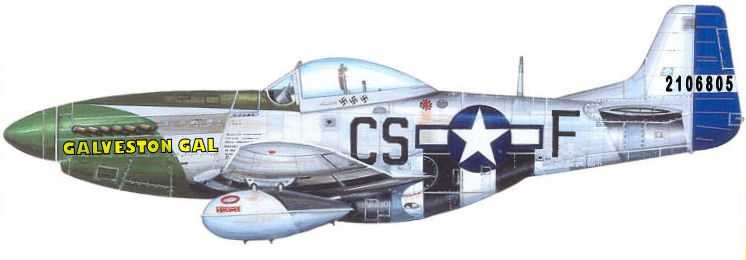
Artistic representation of the paint scheme for the Lone Star Flight Museum's new TF-51D Mustang
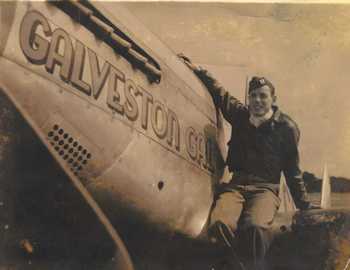 |
The Lone Star Flight Museum in Galveston, Texas has acquired a two seat dual control North American TF-51D Mustang. The aircraft has been flown to a restoration facility to be freshened up and to be painted. The Mustang will be painted in the colors of the 359th Fighter Group, 370th Fighter Squadron, Code CS-F and will be named "Galveston Gal."
The Museum’s President, Larry Gregory, made the announcement today in a ceremony, which included the original pilot of "Galveston Gal," Ray Lancaster.
The Lone Star Flight Museum also owns a Boeing B-17G Flying Fortress painted in the colors of the 303rd Bomb Group and named "Thunderbird." Research shows that on at least twelve occasions aircraft of the 359th Fighter Group flew escort missions for the 303rd Bomb Group. On one of these bomber escort missions, then Lt. Lancaster, while protecting the bombers, shot down one German FW190 fighter and damaged another.
![]()
The Molesworth Pilot
A couple of readers had questions about our choice of the name "The Molesworth Pilot" and wondered if we might be emphasizing air crews over the support organizations. The term "Pilot" is an old-time, traditional name for a newspaper, and many current newspapers still use that name. Other names were considered, but "Pilot" had a nice ring to it and seemed to fit our theme better than "Times" or "Tribune" or "News." The choice of the name had nothing to do with the crew position. As the website will attest, I am a huge supporter of the ground crews and support organizations and consider them equally as important as the combat crews. My father was an officer on an air crew, but when I served in the US Air Force thirty years later, I was an enlisted man on the ground.
Klieglight
Some of you may wonder, "What in the world is a Klieglight?" A Klieglight, often spelled as two words, is a carbon-arc lamp that produces bright light and is used in moviemaking. "Klieglight" is also a seldom used term meaning "the center of attention" or as a synonym of the word "limelight." For me, it had a third meaning from my four years in the USAF Security Service. At that time, a "Klieglight" was a report we were often required to send to NSA. For our purposes here, articles "Under the Klieglight" are the featured articles.
Evening Telegraph Article
The first paragraph of the "Evening Telegraph" article above mentions a previous article about an Army Air Force bomber station. We would love to find a copy of that article. Can anyone help?
|
On February 22, 1944 a B-17 of the 360th Squadron, piloted by 2Lt John R. Morrin, was shot down and crashed near Duffel, Belgium. Recently, the residents of Duffel constructed a monument commemorating the crew. In April 2010, a plaque expressing gratitude for this recognition will be presented to the Belgium town by pilot John Morrin’s son, Jim Morrin. Jim is trying to obtain contact information for the former crewmen or their family members. To date, relatives of only one family have been located, a niece and nephew of Sgt Robert DiStasi. Do you know any of these men or their families?
|
 John T. Eness, 83, of Garner, died on Monday, April 11, 2005, at the Heritage Care Center, Mason City, Iowa.
John served his country in the U.S. Army during WW II as a medical technician. He was stationed in England for two and one-half years in the 303rd U.S. Hospital north of London. Following his honorable discharge he returned to Garner and continued working in the plumbing, heating and air conditioning trade for over 50 years at C. J. Schneider's Hardware and Grocery and Smith's Hardware.
John T. Eness, 83, of Garner, died on Monday, April 11, 2005, at the Heritage Care Center, Mason City, Iowa.
John served his country in the U.S. Army during WW II as a medical technician. He was stationed in England for two and one-half years in the 303rd U.S. Hospital north of London. Following his honorable discharge he returned to Garner and continued working in the plumbing, heating and air conditioning trade for over 50 years at C. J. Schneider's Hardware and Grocery and Smith's Hardware.
Dear Mr. Moncur,Keeping the Legacy Alive,
May I kindly ask if you could place me please on the regular mailing list for updates of the "Molesworth Pilot". I am volunteering in the local American Airpower Museum at Republic Airport in Farmingdale, NY and I already asked you some time ago to correct the crash site of the mission on 6. April 1945 which you did, many thanks. Our volunteer Seymour Cohen (303BG) passed away which you also listed earlier.And please be advised that the 303BG Website is one of the best kept up to date of all such publications. Your photos and paintings are just wonderful and a great tribute to those who served. It is for me of great interest after having grown up In Germany during the air war and the 303BG was overhead on 6 April 1945, with my former colleague on board. This day, just before reaching us as target (Leipzig), a 3-plane midair collision took place with 2 B-17s lost including crew. I did much research on this mission and arranged that relatives of one deceased crew member visited the town of Loessnitz where both planes crashed. They received a mayor's reception with many towns people participating, tears in their eyes and hugging the guests. I have all documented in writing and photos.
Best regards and a Happy New Year, Guenter Bier
Hi, Gary -
What an unbelievable job you've done and continue to do! I am the daughter of O.Z. Rowe - 358th - and I still love hearing Dad tell stories about his time at Molesworth and his missions. Now, his great granddaughters are starting to learn about all of this! Thanks to talented and dedicated folks like you, we will always have this amazing history accurately documented - on the web site and in these newsletters. Gary, thank you so much - I will be forever grateful for all your dedication and hard work in continuing to honor the 303rd.Angie Hewitt
Thanks again Gary for the newsletters, etc. By you taking this publication under your wing, there is no doubt in my mind that the association of 303rd Airmen will prevail for many years. Many of us will be gone, but you will play an important part of their history.
Bill Eisenhart
Gary, Congratulations on launching "The Molesworth Pilot," the electronic successor to the 303rd Bomb Group Association's quarterly printed "Hell's Angels Newsletter." Launching on the 25th anniversary of your father's passing was especially appropriate. He was one of the 303rd's stellar pilots.
Over a span of 30 years the 303rd Bomb Group Association's venerated leader Lew Lyle referred to the original printed newsletter as "the glue that holds us together." "Hell's Angels Newsletter" ceased publication in 2007 with the dissolution of the Association. In a sense, "The Molesworth Pilot" now serves a similar purpose. The web site newsletter is the successor source for news--past, present and future--not only of interest to 303rd veterans but to their families and friends as well.
I had the honor and pleasure of serving as the editor of "Hell's Angels Newsletter" from November 1998 to the final issue in November 2007. Most of my predecessors as editor have passed away, but I have the feeling that in spirit they join me in wishing you clear skies and smooth flying as the newest editor to join our ranks. In most of our tenures stretching back to 1976, a web site was a place where a spider lived.
And thanks for reviving Old English for the name The Molesworth Pilot. That type font is most memorable to readers of the Hell's Angels Newsletter. It was first introduced by then editor Hal Susskind in the May, 1988 issue, and stayed in place to the end of publication 19 years later.
Eddie Deerfield
Thank you Gary, Happy New year to you! It is always sad to receive taps but I sign every guestbook. It is important that all those brave men who fought for our freedom should never be forgotten. In memory of Captain John A. Van Wie, 360th BOMB SQ, 303rd BOMB GP (H).
Martijn van Haren, Netherlands

|
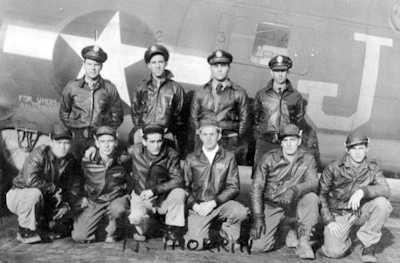 2Lt John R. Morrin (P) (POW)
2Lt John R. Morrin (P) (POW)